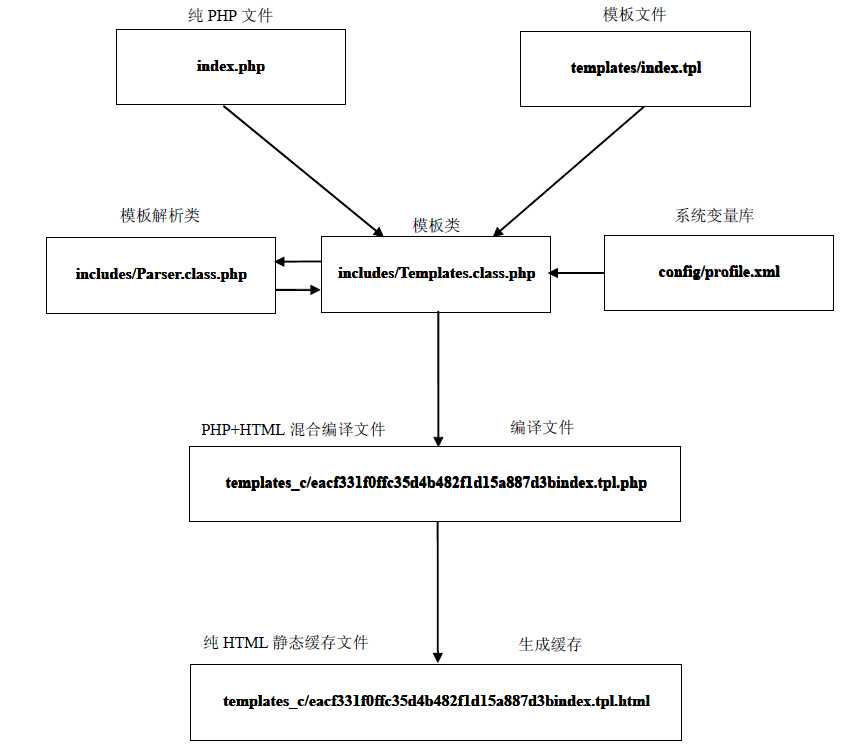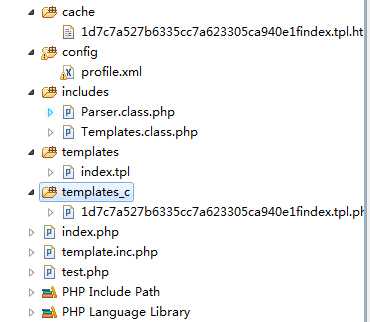此内容用作笔记,以备日后查看,此内容为学习李炎恢课程而来,并非自己所创,如有问题请私信~
将PHP代码和静态HTML代码进行分离,使代码的可读性和维护性得到显著提高。
使用模板引擎:
我们所说的模板是Web模板,是主要由HTML标记组成的语言来编写的页面,但也有如何表示包含动态生成内容的方式(解析标签)。模板引擎是一种软件库,允许我们从模板生成HTML代码,并指定要包含的动态内容。
模板引擎的特点:
1.鼓励分离:让更个系统的可读性和维护性得到提高。
2.促进分工:使得程序员和美工去专心处理自己的设计。
3.比PHP更容易解析:编译文件和缓存文件加载更快、占资源更少。
4.增加安全性:可限制模板设计师进行不安全的操作的能力避免误删误访问等。
模板处理的流程图

创建模板:
1、创建初始模板所需要的文件夹和文件。
a) index.php主文件,用于编写业务逻辑。
b) template.inc.php模板初始化文件,用于初始模版信息。
c) templates目录存放所有的模板文件。
d) templates_c目录存放所有编译文件。
e) cache目录存放所有缓存文件。
f) includes目录存放所有的类文件。
g) config目录存放模板系统变量配置文件。

以下是源码:
主文件 index.php
<?php //index.php //设置编码为UTF-8 header(‘Content-Type:text/html;Charset=utf-8‘); //网站根目录 define(‘ROOT_PATH‘, dirname(__FILE__)); //存放模板文件夹 define(‘TPL_DIR‘, ROOT_PATH.‘/templates/‘); //编译文件夹 define(‘TPL_C_DIR‘, ROOT_PATH.‘/templates_c/‘); //缓存文件夹 define(‘CACHE_DIR‘, ROOT_PATH.‘/cache/‘); //定义缓存状态 define(‘IS_CACHE‘,true); //设置缓存状态开关 IS_CACHE ? ob_start() : null; include ROOT_PATH.‘/includes/Templates.class.php‘; $_name = ‘方块李‘; $array = array(1,2,3,4,5,6); $_tpl = new Templates(); $_tpl->assign(‘name‘, $_name); $_tpl->assign(‘a‘, 5>4); $_tpl->assign(‘array‘, $array); //显示 $_tpl->display(‘index.tpl‘); ?>
模板文件 HTML
<!DOCTYPE html PUBLIC "-//W3C//DTD XHTML 1.0 Transitional//EN" "http://www.w3.org/TR/xhtml1/DTD/xhtml1-transitional.dtd"> <html xmlns="http://www.w3.org/1999/xhtml"> <head> <meta http-equiv="Content-Type" content="text/html; charset=UTF-8" /> <title><!--{webname}--></title> </head> <body> {include "test.php"} <!-- 这是HTML的注释 --> {#}这是一条PHP的注释,在HTML页面里是不显示的,只会在生成的编译文件里显示{#} 我将被index.php导入 {$name}这个标签必须经过Parser.class.php这个解析类来解析它1 <br /> 这里的内容改变了,为什么? <br /> {if $a} 显示一号皮肤 {else} 显示二号皮肤 {/if} <br /> {foreach $array(key,value)} {@key}....{@value} <br /> {/foreach} </body> </html>
模板类:

//Templates.class.php class Templates { //创建一个存放数组的字段 private $_vars = array(); private $_config = array(); //创建一个构造方法 public function __construct(){ if(!is_dir(TPL_DIR) || !is_dir(TPL_C_DIR) || !is_dir(CACHE_DIR) ){ exit(‘ERROR:模板文件夹或者编译文件夹或者缓存文件夹没有创建!‘); } //获取系统变量 $_sxe = simplexml_load_file(ROOT_PATH.‘/config/profile.xml‘); $_taglib = $_sxe->xpath(‘/root/taglib‘); foreach($_taglib as $_tag){ $this->_config["$_tag->name"] = $_tag->value; } } //创建变量注入方法 /** * assign()变量注入方法 * @param $_var 要注入的变量名,对应.tpl文件中的需要替换的变量 * @param $_values 要注入的变量值 */ public function assign($_var,$_values){ if(isset($_var) && !empty($_var)){ $this->_vars[$_var] = $_values; }else{ exit(‘ERROR:请设置变量名!‘); } } //创建一个显示方法,用来显示编译后的文件 public function display($_file){ //设置模板文件的路径 $_tplFile = TPL_DIR.$_file; //判断模板文件是否存在 if(!file_exists($_tplFile)){ exit(‘ERROR:模板文件不存在‘); } //设置编译文件名 $_parFile = TPL_C_DIR.md5($_file).$_file.‘.php‘; //设置缓存文件名 $_cacheFile = CACHE_DIR.md5($_file).$_file.‘.html‘; //判断缓存状态 if(IS_CACHE){ //判断缓存文件是否存在 if(file_exists($_cacheFile) && file_exists($_parFile)){ //是否修改过编译文件或者模板文件 if(filemtime($_cacheFile)>=filemtime($_parFile) && filemtime($_parFile)>filemtime($_tplFile)){ echo ‘以下是缓存文件内容‘; echo "<br />"; include $_cacheFile; return; } } } //判断编译文件是否存在,模板文件是否修改过 if(!file_exists($_parFile) || (filemtime($_parFile) < filemtime($_tplFile))){ //引入模板解析类 require ROOT_PATH.‘/includes/Parser.class.php‘; //实例化对象,生成编译文件 $_parser = new Parser($_tplFile);//模板文件 $_parser->compile($_parFile);//编译后文件 } //载入编译文件 include $_parFile; if(IS_CACHE){ //生成缓存文件 file_put_contents($_cacheFile, ob_get_contents()); //清除缓冲区 ob_end_clean(); //载入缓存文件 include $_cacheFile; } } }
解析类:

//Parser.class.php class Parser { //获取模板内容 private $_tpl; //构造方法,初始化模板 public function __construct($_tplFile){ //判断文件是否存在 if(!$this->_tpl = file_get_contents($_tplFile)){ exit(‘ERROR:读取模板出错!‘); } } //解析普通变量 private function parVar(){ $_pattern = ‘/\{\$([\w]+)\}/‘; if (preg_match($_pattern,$this->_tpl)) { $this->_tpl = preg_replace($_pattern,"<?php echo \$this->_vars[‘$1‘] ?>",$this->_tpl); } } //解析IF条件语句 private function parIf(){ //开头if模式 $_patternIf = ‘/\{if\s+\$([\w]+)\}/‘; //结尾if模式 $_patternEnd = ‘/\{\/if\}/‘; //else模式 $_patternElse = ‘/\{else\}/‘; //判断if是否存在 if(preg_match($_patternIf, $this->_tpl)){ //判断是否有if结尾 if(preg_match($_patternEnd, $this->_tpl)){ //替换开头IF $this->_tpl = preg_replace($_patternIf, "<?php if(\$this->_vars[‘$1‘]){ ?>", $this->_tpl); //替换结尾IF $this->_tpl = preg_replace($_patternEnd, "<?php } ?>", $this->_tpl); //判断是否有else if(preg_match($_patternElse, $this->_tpl)){ //替换else $this->_tpl = preg_replace($_patternElse, "<?php }else{ ?>", $this->_tpl); } }else{ exit(‘ERROR:语句没有关闭!‘); } } } //解析foreach private function parForeach(){ $_patternForeach = ‘/\{foreach\s+\$(\w+)\((\w+),(\w+)\)\}/‘; $_patternEndForeach = ‘/\{\/foreach\}/‘; //foreach里的值 $_patternVar = ‘/\{@(\w+)\}/‘; //判断是否存在 if(preg_match($_patternForeach, $this->_tpl)){ //判断结束标志 if(preg_match($_patternEndForeach, $this->_tpl)){ //替换开头 $this->_tpl = preg_replace($_patternForeach, "<?php foreach(\$this->_vars[‘$1‘] as \$$2=>\$$3){?>", $this->_tpl); //替换结束 $this->_tpl = preg_replace($_patternEndForeach, "<?php } ?>", $this->_tpl); //替换值 $this->_tpl = preg_replace($_patternVar, "<?php echo \$$1?>", $this->_tpl); }else{ exit(‘ERROR:Foreach语句没有关闭‘); } } } //解析include private function parInclude(){ $_pattern = ‘/\{include\s+\"(.*)\"\}/‘; if(preg_match($_pattern, $this->_tpl,$_file)){ //判断头文件是否存在 if(!file_exists($_file[1]) || empty($_file[1])){ exit(‘ERROR:包含文件不存在!‘); } //替换内容 $this->_tpl = preg_replace($_pattern, "<?php include ‘$1‘;?>", $this->_tpl); } } //解析系统变量 private function configVar(){ $_pattern = ‘/<!--\{(\w+)\}-->/‘; if(preg_match($_pattern, $this->_tpl,$_file)){ $this->_tpl = preg_replace($_pattern,"<?php echo \$this->_config[‘$1‘] ?>", $this->_tpl); } } //解析单行PHP注释 private function parCommon(){ $_pattern = ‘/\{#\}(.*)\{#\}/‘; if(preg_match($_pattern, $this->_tpl)){ $this->_tpl = preg_replace($_pattern, "<?php /*($1) */?>", $this->_tpl); } } //生成编译文件 public function compile($_parFile){ //解析模板变量 $this->parVar(); //解析IF $this->parIf(); //解析注释 $this->parCommon(); //解析Foreach $this->parForeach(); //解析include $this->parInclude(); //解析系统变量 $this->configVar(); //生成编译文件 if(!file_put_contents($_parFile, $this->_tpl)){ exit(‘ERROR:编译文件生成失败!‘); } } }
总结:模板引擎的整个过程:
1、当浏览器请求index.php文件时,实例化模板类对像 $_tpl = new Templates();
2、当Templates实例化的时候,生成两个数组,一个用来存放模板变量,另一个存放系统变量,通过构造方法,判断文件夹是否存在,同时通过XML文件将系统变量数组初始化
3、通过模板类Templates的注入方法,assign(),将对应模板index.tpl中变量的index.php的内容注入到模板类的私有变量,完成初始化
4、模板类Templates类显示方法display() 通过实例化解析类Parser,将取到的注入变量通过解析类进行解析(即替换)
5、解析(替换)后,将文件写入PHP、HTML混全文件
6、通过Templates类的显示方法将文件输出:
1、第一次执行显示方法时,将会把PHP、HTML混合文件,生成纯静态的缓存文件
2、调用缓存文件,显示页面
3、当浏览器再次调用显示方法时,首先根据各文件的最后修改时间,判断是否重新生成缓存文件或直接调用已存在的缓存文件
重点:
1、通过正则表达式进行字符串的替换
2、熟悉OOP
转:https://www.cnblogs.com/fkli/p/4810675.html

